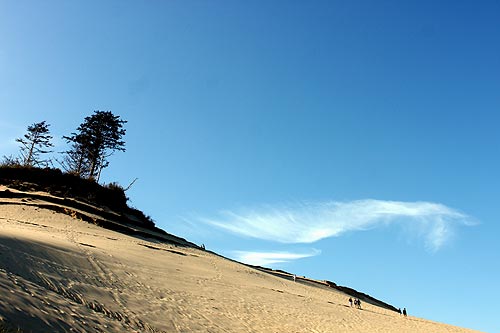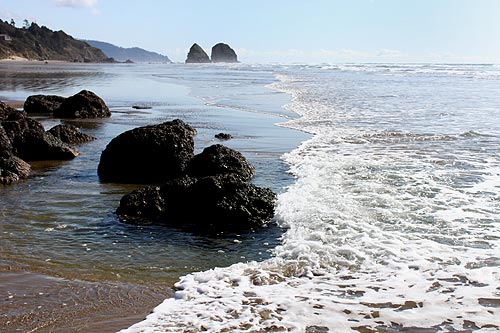Spring Equinox Monday Has Trippy Astronomy for Oregon, the Coast
Published 03/17/2017 at 4:03 AM PDT
By Oregon Coast Beach Connection staff

(Oregon Coast) – Spring will swoop down into Oregon and the coast on Monday, March 20, with the season officially starting at 3:29 a.m. that morning. It is technically known as the vernal equinox: the day when both the north and south poles of the Earth are at equal distance towards the sun – which is 92.6 million miles away.
Jim Todd, astronomy expert with Portland's OMSI, said at that moment the sun will be directly over the Earth's equator.
“We will then be halfway towards summer, with the winter days soon behind us for another year,” Todd said. “The first day of spring, or the 'vernal' equinox, gets its term from vernal meaning 'green', and equinox meaning 'equal night', which simply means that on this equinox which edges us into the warmer months, the hours of daylight are equal to the hours of night.”
It's interesting to note the sunrise and sunset differences between the Oregon coast and inland, according to the Old Farmer's Almanac. On March 20, sunrise for both Cannon Beach and Newport (100 or so miles apart) is listed at 7:16 a.m. Sunset for both towns is at 7:29 p.m.
In Portland, sunrise is at 7:10 a.m. - six minutes earlier than the coast. Sunset inland is at 7:24 p.m., about five minutes earlier than the beaches.
Head even farther south to Coos Bay and sunset and sunrise are one minute later than Newport and Cannon Beach.
Todd let on a few other fun facts about the equinox in Oregon. In Portland, for example, the noon sun attains its absolute mid-point in the sky at 1:18 p.m., where it will be 45 degrees from the southern horizon.
“On the first day of spring, the sun rises exactly due east and sets exactly due west,” Todd said.
Each day after that it rises just a little bit farther north until the summer solstice on June 20. It will set in the same place for a few days after that.
On March 20, day and night will be equal length over just about all of the Earth, except at the poles. That's when some trippy refraction takes place: where the curvature of the Earth's atmosphere actually bends the sun's rays. This will make the sun visible there through the night, even during those 12 hours the sun is below the horizon. Oregon Coast Lodgings for this event - Where to eat - Maps - Virtual Tours
More About Oregon Coast hotels, lodging.....
More About Oregon Coast Restaurants, Dining.....
Cannon Beach Lodging
Nehalem Bay Lodgings
Manzanita Hotels, Lodging
Three Capes Lodging
Pacific City Hotels, Lodging
Lincoln City Lodging
Depoe Bay Lodging
Newport Lodging
Waldport Lodging
Yachats Lodging
Oregon Coast Vacation Rentals
Oregon Coast Lodging Specials
LATEST Related Oregon Coast Articles
Likely just before dawn best hour but peak happens during daylight. Weather
Dark Sky Week is Prime Along Oregon Coast: Where and Where Not to Go
General guide to dark sky viewing from south to north coast. Astronomy
Sizable Price Drop, Deals in Lincoln City During Quiet of April on Central Or...
20 perc off at A1 Vacation Rentals across its roster, including Gleneden Beach. Lincoln City specials
Upcoming S. Oregon Coast Events Include Gem Show, History: Coos Bay, Bandon
May 6 talk at Coos History Museum, Mayfly Fest May 17, Bandon Rock / Gem Show June 7,8
Washington Coast Cleanup on April 19 - Coinciding with Oregon Coast's SOLVE E...
From the Puget Sound to Long Beach, alongside Oregon's cleanup. Washington coast events, Seaside events
Astoria's Riverwalk Gets New Lighting, More N. Oregon Coast Roadwork
Delays coming this summer, but the riverwalk has a new look. Seaside, Cannn Beach
April Gets Even Cheaper Midweek at Depoe Bay, Lincoln City: Oregon Coast Deals
Off-season rates plus more at Keystone Vacation Rentals. Depoe Bay lodging specials, Lincoln City hotel reviews, Newport hotel reviews
Washington Coast Begins Week of Clam Digs, April 12 Through 18
Long Beach, Twin Harbors, Mocrocks and Copalis at different times. Washington coast events
Back to Oregon Coast
Contact Advertise on BeachConnection.net
All Content, unless otherwise attributed, copyright BeachConnection.net Unauthorized use or publication is not permitted


















































